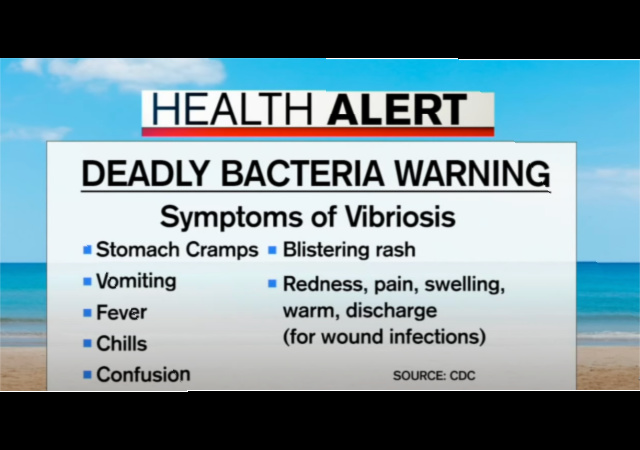Texas Authorities Warn of Rising Flesh-Eating Bacteria Cases Along Gulf Coast
Meanwhile, researchers at Washington University School of Medicine in St. Louis have developed a new antibiotic treatment that effectively clears serious infections, including those related to flesh-eating bacteria.

Last month, Texas public health authorities warned of a concerning outbreak of flesh-eating bacteria along the state’s Gulf Coast.
Officials in Galveston County reported 11 cases of vibrio infections since June, compared to only two during the same interval last year. Of those infected, eight were from out of town.
Vibrio bacteria occur naturally in coastal waters, including salt water and brackish water, a mixture of salt and fresh water. It is found in higher concentrations from May to October when water temperatures are warmer.
Vibrio can cause two kinds of illnesses. The more common is caused by eating raw or undercooked shellfish, particularly oysters. Symptoms include abdominal cramps, diarrhea, nausea, vomiting and dehydration.
The other, potentially more serious infection occurs when an open wound comes into contact with coastal waters. Most of the cases in Galveston were the result of contact with water, a spokesperson for the Galveston County Health Department said in an email Friday.
Symptoms can include fever and redness, pain, swelling, warmth, discoloration and discharge of fluid around the wound, according to the U.S. Centers for Disease Control and Prevention.
In the worst cases, the bacteria can lead to necrotizing fasciitis, a severe infection in which the flesh around an open wound dies, which is why vibrio is frequently called a “flesh-eating bacteria.”
It would be interesting to know about the “out of town” cases in which the infection was contracted. Hopefully, this is not a future trend for those who enjoy the waters along the Texas Gulf Coast region.
Between 700 and 1,150 cases of necrotizing fasciitis are diagnosed in the U.S. every year, and up to 1 in 5 infections result in death. Those with a weakened immune system or who have certain diseases (e.g., heart disease, diabetes) are at higher risk of getting necrotizing fasciitis.
When an infection occurs, it can strike hard and quickly. One of the recent outbreak victims contracted the infection when he stepped into the waters near Freeport without realizing he had an open wound.
The man, identified to KHOU-TV as Randy Bunch by relatives, was crabbing and fishing in Freeport when he stepped into shallow water off a boat ramp to retrieve a crab trap.
His daughter, Brandy Pendergraft, of Pearland, told the news station that her father had not noticed a small, days-old scrape on his right foot. A few hours later, Bunch was in pain and went to the emergency room, she told the Houston-area outlet.
When the doctor could not find anything wrong, Bunch was released and went home, she said. By the next morning, he had a 104-degree fever and was disoriented. Bunch returned to a hospital, where doctors determined he had contracted vibrio bacteria.
“The blisters were taking over his whole body,” Pendergraft told KHOU. “It was spreading. Just like a fire.”
Bunch died less than a week after he stepped into the water.
But there is some good news from the world of medicine. Researchers at Washington University School of Medicine in St. Louis have developed a new treatment that effectively clears bacterial infections in mice, including those that can result in “flesh-eating” illnesses.
The compound targets gram-positive bacteria, which can cause drug-resistant staph infections, toxic shock syndrome and other illnesses that can turn deadly.
It was developed through a collaboration between the Washington University labs of Scott Hultgren, PhD, the Helen L. Stoever Professor of Molecular Microbiology, and Michael Caparon, PhD, a professor of molecular microbiology, and Fredrik Almqvist, a professor of chemistry at the University of Umeå in Sweden.
A new type of antimicrobial would be very good news for clinicians seeking effective treatments against dangerous pathogens that are becoming more resistant to currently available drugs.
“All of the gram-positive bacteria that we’ve tested have been susceptible to that compound. That includes enterococci, staphylococci, streptococci, C. difficile, which are the major pathogenic bacteria types,” said Caparon, the co-senior author. “The compounds have broad-spectrum activity against numerous bacteria.”
It would be a wonderful development if the new drug proved effective in humans for cases where standard antibiotic treatments failed.
 DONATE
DONATE
Donations tax deductible
to the full extent allowed by law.








Comments
I can think of 741 people I wish these bacteria would devour.
Boy, those symptoms read like the possible side effects listed in the 27 minutes of all the drug ads packed into every hour of Fox News.
Poor man! You know you have to push hard at times to get the ER doctors to really investigate these things. Maybe he wouldn’t have died if he had been treated earlier.
My thought exactly.
Medical care in America has gone rapidly downhill with lax medical schools, DEI, influx of NP’s who have very little experience and get th ER it advanced degree literally online
yes
the dems are parasitic leeches
Think of all the money that this flesh-eating bacteria can save on Ozempic.
Yes it’s called socialism/wokism
I’m hearing a lot of rumors about flesh eating bacteria in the Rio Grande.
Unfortunately there is not enough salt water to sustain the environment required. On the other hand, the CDC is probably lying again!
Survives in salt water, resistant(immune) to antibiotics. Nature is good at bio-warfare too.
Leave a Comment